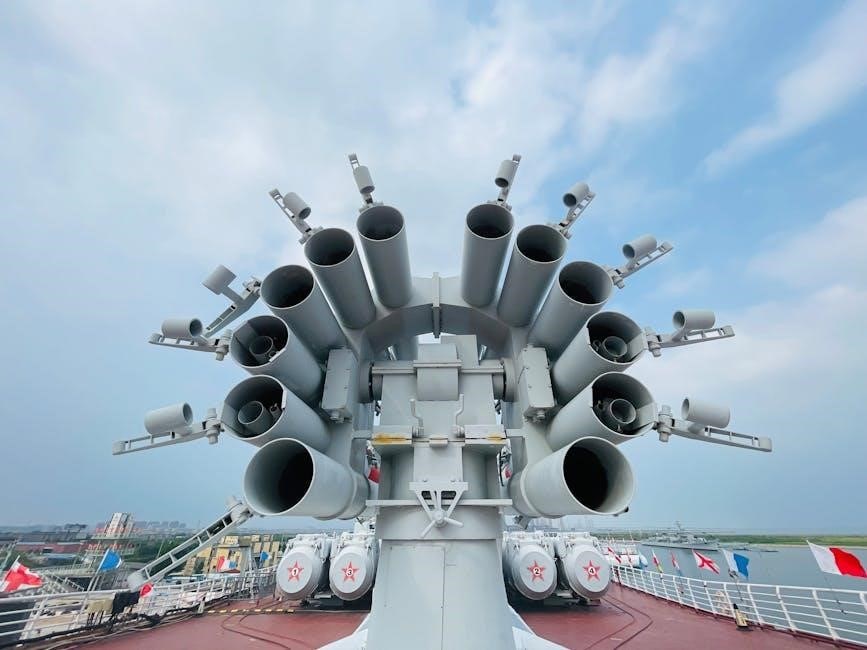Anti-ship missiles are guided weapons designed to attack and destroy naval vessels, leveraging advanced propulsion and guidance systems for precision strikes. Modern variants, such as the U.S. Navy’s LRASM, emphasize extended range and stealth capabilities to counter evolving threats. These missiles play a critical role in naval warfare, enabling forces to dominate maritime domains. Their development reflects a continuous arms race, with nations seeking to outpace adversaries in range, speed, and accuracy.
Overview of Anti-Ship Missiles
Anti-ship missiles are precision-guided weapons designed to target and destroy naval vessels. They vary in range, speed, and capabilities, with modern systems emphasizing stealth and extended reach. The U.S. Navy’s LRASM, for instance, boasts a range of over 200 miles, while Russia’s Moskit missile can strike targets at 155 miles. These missiles are integral to naval warfare, enabling nations to project power across maritime domains. Their development and deployment reflect a constant evolution in technology, driven by the need to counter advancing threats and maintain strategic superiority at sea.
Historical Development of Anti-Ship Missiles
The development of anti-ship missiles began in the mid-20th century, with the Soviet Union pioneering the P-15 Termit missile in the 1950s. The 1967 sinking of the Israeli destroyer Eilat by Soviet-made missiles marked a turning point, demonstrating their lethal effectiveness. During the Cold War, both the U.S. and Soviet Union advanced their capabilities, with the U.S. introducing the Harpoon missile and the Soviets developing the Exocet equivalent. By the 1980s, anti-ship missiles had become a cornerstone of naval warfare, with systems like the Tomahawk and Exocet proving decisive in conflicts. Their evolution reflects the continuous race for maritime dominance.


Key Characteristics of Modern Anti-Ship Missiles
Modern anti-ship missiles are distinguished by their advanced propulsion systems, enabling supersonic or high-subsonic speeds. They feature sophisticated guidance mechanisms, including inertial navigation, GPS, and active radar seekers, ensuring high precision. Many are equipped with stealth technology to evade enemy defenses. Long-range capabilities, such as the LRASM’s over 200 nautical miles, allow strikes beyond radar horizons. Additionally, some missiles can perform evasive maneuvers and target reassignment mid-flight, complicating defense systems. These attributes make them formidable threats in contemporary naval warfare, necessitating robust countermeasures.
Current Threat Landscape
The threat landscape is escalating, with Russia and China deploying advanced anti-ship missiles like the Moskit and YJ-18, posing significant risks to U.S. warships globally.
Russia’s Advanced Anti-Ship Missiles
Russia has developed formidable anti-ship missiles, such as the P-800 Oniks and Kalibr-NK, which boast ranges of up to 300 km and 1,500 km, respectively. These systems pose a significant threat to U.S. warships by combining high speed, precision, and the ability to evade defenses. The P-800 Oniks, in particular, operates with a fire-and-forget capability, allowing launch platforms to retreat after firing. Such advanced missiles underscore Russia’s commitment to countering naval superiority, making them a critical concern in modern maritime warfare strategies.
China’s Growing Anti-Ship Missile Capabilities
China has rapidly advanced its anti-ship missile arsenal, with systems like the YJ-18 and CM-401, featuring ranges exceeding 200 km and 1,000 km, respectively. These missiles incorporate advanced propulsion and guidance, enhancing their lethality against U.S. warships. The YJ-18, with its supersonic terminal stage, poses a significant threat due to its speed and maneuverability. China’s focus on long-range capabilities aims to counter U.S. naval dominance in the Pacific, marking a strategic shift in regional power dynamics and increasing tensions in maritime security.
Regional Threats and Proliferation
Regional threats from anti-ship missiles have intensified, with nations like Iran and North Korea developing capable systems. Iran’s Noor missile, a variant of the Chinese C-802, poses risks in the Persian Gulf. North Korea’s KN-09 and KN-11 missiles threaten naval forces in the Pacific. Russia’s Kalibr-NK and China’s YJ-18 are exported to allies, enhancing regional adversaries’ capabilities. This proliferation escalates tensions, as smaller nations gain access to advanced missiles, challenging U.S. warships’ dominance and complicating global maritime security dynamics.

Types of Anti-Ship Missiles
Modern anti-ship missiles include the U.S. Navy’s LRASM, Harpoon, Russia’s Kalibr-NK, China’s YJ-18, and France’s Exocet. Each system offers unique range, speed, and precision capabilities.
Long-Range Anti-Ship Missiles (LRASM)
The Long-Range Anti-Ship Missile (LRASM) is a state-of-the-art U.S. Navy weapon designed for engaging enemy ships at extended ranges. Equipped with advanced seeker technology, LRASM uses autonomous targeting to identify and strike high-value maritime targets, even in contested environments. Its range exceeds 200 miles, making it a critical asset for power projection. LRASM’s cost-effectiveness and precision ensure it remains a cornerstone of U.S. naval superiority, capable of countering advanced threats from adversaries like Russia and China.
Harpoon Anti-Ship Missile System
The Harpoon Anti-Ship Missile System is a well-established, all-weather, over-the-horizon missile designed to engage surface warships. With a range of approximately 150 kilometers, it combines speed and precision to deliver lethal force. Launched from submarines, ships, or aircraft, Harpoon’s versatility enhances naval capabilities. Its reliable performance and adaptability have made it a trusted asset for the U.S. Navy and allied forces, ensuring effective engagement of hostile targets at sea.
Russian Kalibr-NK Missile System
The Russian Kalibr-NK Missile System is a highly advanced, long-range anti-ship missile capable of striking naval targets at distances exceeding 1,500 miles. Deployed from submarines and surface ships, it features high precision and the ability to evade missile defenses. Its modular design allows for various payloads, enhancing versatility. The Kalibr-NK has become a cornerstone of Russia’s naval power, enabling strategic dominance in regional conflicts and deterring adversaries through its unmatched reach and lethality.
Chinese YJ-18 Anti-Ship Missile
The Chinese YJ-18 anti-ship missile is a supersonic, sea-skimming weapon with a range of approximately 360 miles. It combines high speed and maneuverability to penetrate advanced naval defenses. Deployed from submarines and surface vessels, the YJ-18 poses a significant threat to enemy fleets. Its advanced propulsion system and robust guidance ensure precision targeting, making it a key asset in China’s naval arsenal. This missile underscores China’s commitment to modernizing its military capabilities, particularly in countering regional maritime threats.

Range and Capabilities
Modern anti-ship missiles feature extended ranges, often exceeding 200 miles, enabling strikes beyond radar detection. Advanced propulsion systems and precision guidance enhance lethality, challenging naval defenses and altering warfare strategies.
Range Comparison of Modern Anti-Ship Missiles
Modern anti-ship missiles vary significantly in range, with the U.S. LRASM reaching up to 200-300 miles, while Russia’s Kalibr-NK exceeds 1,500 miles. China’s YJ-18 operates at 290-360 miles. These ranges reflect strategic priorities, enabling nations to project power across vast maritime zones. The extended reach of Russian and Chinese systems challenges U.S. naval dominance, necessitating advanced countermeasures. Such comparisons highlight the evolving nature of naval warfare, where range and precision dictate operational advantage.
Impact of Range on Naval Warfare Strategies
The range of anti-ship missiles significantly influences naval warfare strategies, enabling ships to engage targets from safer distances and reducing vulnerability to counterattacks. Longer-range missiles, such as Russia’s Kalibr-NK, allow nations to project power across vast maritime areas, shifting the balance of power. This forces adversaries to adopt defensive measures like early warning systems and layered defenses. The psychological impact of superior range also affects decision-making, as commanders must consider the risk of being outmatched. Consequently, range drives fleet positioning, doctrine, and the arms race, shaping modern naval warfare’s strategic landscape.
Advanced Propulsion Systems for Extended Range
Modern anti-ship missiles employ advanced propulsion systems to achieve extended range and enhanced lethality. Solid-fuel boosters combined with turbojet or ramjet engines enable sustained high speeds and longer flight distances. Hypersonic propulsion, as seen in Russia’s Zircon, pushes the boundaries of speed and range, making interception increasingly difficult. Additionally, miniaturized electronics and optimized fuel efficiency further enhance missile performance. These advancements ensure missiles can strike targets beyond traditional engagement zones, significantly expanding their operational effectiveness and strategic impact in naval warfare scenarios.
Defensive Systems Against Anti-Ship Missiles
Modern naval defenses employ multi-layered systems, including the Aegis Combat System and SM-6 missiles, alongside electronic warfare and countermeasures, to detect, track, and disrupt incoming anti-ship missiles effectively.
Aegis Combat System and Missile Defense
The Aegis Combat System is a cornerstone of U.S. naval defense, integrating radar, fire control, and missile systems to neutralize threats. Its AN/SPY-1 radar provides unparalleled detection and tracking of anti-ship missiles, enabling timely interceptions. Paired with SM-6 missiles, Aegis ensures robust defense against supersonic and maneuvering threats. This system’s scalability across destroyers and cruisers enhances fleet-wide protection, making it pivotal in countering advanced missile threats from adversaries like Russia and China.
Role of SM-6 Missiles in Defense
The SM-6 missile is a dual-role interceptor, excelling in both anti-air and anti-ship missile defense. Its extended range enables U.S. warships to engage threats beyond the horizon, complementing the Aegis Combat System. With advanced guidance, the SM-6 can intercept supersonic missiles, providing a robust layer of defense against advanced threats. Its versatility and lethality make it a critical asset for protecting fleets from evolving missile threats, ensuring naval superiority in contested maritime environments.
Electronic Warfare and Countermeasures
Electronic warfare (EW) and countermeasures are vital in countering anti-ship missile threats. These systems disrupt enemy radar, communications, and guidance, reducing missile accuracy. Techniques include jamming, spoofing, and saturating sensors with false targets. Modern warships employ decoys like chaff and electronic counter-countermeasures to evade attacks. Advanced EW systems enable ships to remain undetected or confuse incoming missiles. These capabilities are critical in denying adversaries targeting advantages, ensuring survival in high-threat environments. Continuous innovation in EW is essential to stay ahead of evolving missile technologies and maintain naval dominance.
US Navy’s Response to the Threat
The US Navy is modernizing its capabilities to counter anti-ship missile threats, focusing on advanced missile systems, AI integration, and collaborative strategies with allies to ensure maritime superiority.
Development of New Anti-Ship Missile Systems
The US Navy is actively developing next-generation anti-ship missiles to enhance its offensive capabilities. These systems, such as the Long Range Anti-Ship Missile (LRASM), incorporate advanced technologies like AI and stealth to extend range and precision. With a focus on countering adversaries, these missiles are designed to operate in contested environments, ensuring superiority in maritime conflicts. Their development underscores the Navy’s commitment to maintaining a robust deterrent against evolving threats.
Integration of AI in Missile Defense
The integration of AI in missile defense systems is revolutionizing how the US Navy counters anti-ship threats. AI enhances real-time data processing, enabling faster detection and interception of incoming missiles. Advanced algorithms improve predictive analytics, allowing systems to anticipate missile trajectories and optimize countermeasure deployment. AI-driven solutions also enhance situational awareness, ensuring more accurate decision-making. This technological leap strengthens the Navy’s ability to defend against sophisticated anti-ship missiles, maintaining a critical edge in maritime security and operational effectiveness.
Collaborative Efforts with Allies
The US Navy is enhancing its anti-ship missile capabilities through collaborative efforts with key allies. By arming Pacific allies like Australia, Japan, and Taiwan with advanced anti-ship missiles, the US strengthens regional defense networks. Joint military exercises and intelligence sharing improve interoperability, ensuring a unified response to maritime threats. These alliances also facilitate the development of standardized missile systems, enhancing collective deterrence against adversaries. Such cooperation is critical in countering the growing naval capabilities of China and Russia, ensuring a balanced and secure maritime environment.
Arms Race in Anti-Ship Missile Technology
The US, Russia, and China are engaged in a competitive race to develop advanced anti-ship missiles, with each nation seeking to outpace others in range, speed, and precision.
US vs. Russia in Missile Development
The US and Russia are locked in a high-stakes competition to dominate anti-ship missile technology. The US has developed the Long-Range Anti-Ship Missile (LRASM), capable of evading advanced defenses with a range exceeding 200 miles. Russia counters with the Kalibr-NK and 3M22 Tsirkon hypersonic missiles, which boast ranges of up to 1,500 miles and speeds of Mach 9. Both nations prioritize stealth, precision, and extended reach to outpace adversaries in naval warfare, reflecting a strategic focus on controlling maritime domains and deterring hostile actions.
China’s Rapid Advancements
China has made remarkable strides in anti-ship missile technology, significantly enhancing its naval capabilities. The YJ-18 and YJ-21 missiles demonstrate extended ranges and supersonic speeds, challenging regional security. These advancements underscore China’s focus on dominating maritime domains, particularly in the Pacific, and highlight the need for robust countermeasures by the U.S. and its allies to maintain strategic balance and protect critical sea lanes from potential threats.
Global Implications of the Arms Race
The intensifying arms race in anti-ship missile technology has profound global implications, reshaping naval power dynamics and regional security. Advanced missile systems, particularly from China and Russia, are disrupting the balance of power in strategic regions like the Indo-Pacific. This escalation is driving increased defense spending and prompting nations to modernize their fleets. The race also raises concerns about accidental conflicts and the destabilization of critical sea lanes. As tensions rise, the need for diplomatic solutions becomes urgent to prevent further escalation and ensure global stability.

Case Studies and Incidents
Historical incidents like the sinking of the Israeli destroyer Eilat by Soviet-made P-15 Termit missiles in 1967 and the 1987 attack on the USS Stark highlight the lethal impact of anti-ship missiles. These events underscore their strategic significance in naval warfare and the critical need for advanced defense systems. Modern tests, such as China’s 2023 missile drills, demonstrate ongoing capabilities and escalating tensions, shaping global naval strategies and defense priorities.
Historical Incidents Involving Anti-Ship Missiles
The sinking of the Israeli destroyer Eilat in 1967 by Soviet-made P-15 Termit missiles marked a pivotal moment, demonstrating the lethal effectiveness of anti-ship missiles. Similarly, the 1987 attack on the USS Stark by Iraqi Exocet missiles highlighted vulnerabilities in naval defense systems. These incidents underscored the strategic importance of anti-ship missiles in naval warfare, driving advancements in both missile technology and countermeasures. Such historical events have shaped modern naval strategies, emphasizing the need for advanced missile systems and robust defense mechanisms to protect warships at sea.
Recent Missile Tests and Demonstrations
Recent tests of anti-ship missiles have showcased advancements in range and precision. The U.S. Navy successfully fired Long Range Anti-Ship Missiles (LRASM) from a B-1B bomber, demonstrating their extended range and ability to engage targets at sea. Similarly, China conducted live-fire exercises with the YJ-18 missile, highlighting its supersonic capabilities. These tests underscore the ongoing efforts by global naval powers to enhance their anti-ship missile capabilities, reflecting the escalating competition in maritime warfare and the critical need for advanced missile systems to maintain operational superiority.

Impact on Global Naval Strategies
The proliferation of advanced anti-ship missiles has significantly influenced global naval strategies, prompting nations to adapt their fleet deployments and defense systems. The extended range and precision of modern missiles have shifted the balance of power, encouraging a more distributed naval presence to mitigate vulnerabilities. This has also led to increased investments in missile defense and electronic warfare capabilities. Furthermore, the deployment of such missiles in contested regions, such as the Indo-Pacific, has heightened tensions and redefined the dynamics of maritime conflict, underscoring their role in shaping modern naval warfare.

Challenges in Countering Anti-Ship Missiles
Modern anti-ship missiles pose challenges due to their speed, range, and stealth, making detection difficult. Saturation attacks and high costs of defense systems further complicate countermeasures.
Limitations of Current Defense Systems
Current defense systems against anti-ship missiles face challenges, including the difficulty in detecting stealth-capable missiles and the high speeds of advanced projectiles. Many systems struggle to engage multiple incoming threats simultaneously, making saturation attacks a significant concern. Additionally, the cost and complexity of maintaining advanced missile defense systems limit their widespread deployment. These limitations underscore the need for continuous innovation to counter evolving anti-ship missile technologies effectively.
Vulnerabilities in Shipborne Systems
Shipborne defense systems often struggle to detect stealth-capable anti-ship missiles, which can evade radar until the final stages of attack. High-speed missiles can overwhelm shipboard defenses, while electronic countermeasures can disrupt guidance systems. Additionally, the limited number of interceptors on board means that saturation attacks can deplete defenses quickly. These vulnerabilities highlight the need for advanced detection technologies and more robust layered defense strategies to protect naval assets effectively in contested maritime environments.
Cost and Complexity of Advanced Missiles
Modern anti-ship missiles, such as the LRASM and hypersonic variants, are highly sophisticated, driving up development, production, and operational costs. Their advanced propulsion systems, AI-driven guidance, and multi-role capabilities require significant investment. Maintenance and training further increase expenses. Additionally, the complexity of integrating these missiles into existing naval systems poses technical and logistical challenges. These factors make advanced missiles a costly yet critical component of naval arsenals, necessitating careful budget planning and strategic prioritization by defense forces worldwide.

Future Developments and Innovations
Future advancements in anti-ship missiles will focus on hypersonic technology, AI-driven guidance, and miniaturization for increased lethality and versatility. These innovations aim to enhance range and precision, ensuring dominance in naval warfare.
Emerging Technologies in Missile Design
Emerging technologies in anti-ship missile design include hypersonic propulsion, artificial intelligence for adaptive targeting, and advanced materials for reduced radar signatures. Hypersonic missiles, such as Russia’s Zircon, boast speeds over Mach 5, enabling rapid strikes beyond current defense capabilities. AI integration enhances precision and survivability by enabling real-time target tracking and evasion maneuvers. Additionally, miniaturized systems and modular designs allow for greater flexibility and payload efficiency, ensuring missiles can adapt to evolving threats. These innovations are reshaping the balance of power in naval warfare, driving a race for superiority at sea.
Role of Hypersonic Missiles in Future Conflicts
Hypersonic missiles, capable of speeds over Mach 5, are poised to revolutionize naval warfare by compressing reaction times and overwhelming defense systems. Their ability to strike from unexpected angles and deliver precision strikes enhances their lethality against warships. Nations like Russia and China are advancing these technologies, creating a strategic imbalance. Hypersonic missiles will likely dominate future conflicts, forcing naval forces to adapt with advanced countermeasures. Their deployment promises to reshape global maritime power dynamics and escalate tensions in contested regions.
Next-Generation Defense Mechanisms
Next-generation defense mechanisms against anti-ship missiles focus on integrated systems combining AI-driven detection, advanced radar, and high-speed interceptors. The U.S. Navy’s Aegis Combat System and SM-6 missiles exemplify this evolution, offering multi-layered defense. Directed energy weapons, such as lasers, are being tested to counter high-speed threats. Additionally, electronic warfare and cyber capabilities aim to disrupt missile guidance. These innovations seek to stay ahead of adversaries, ensuring survivability in an era of hypersonic and autonomous missile technologies. They represent a critical shift toward proactive and adaptive defense strategies in naval warfare.
The evolution of anti-ship missiles highlights their critical role in naval warfare, emphasizing range, speed, and precision. The ongoing arms race underscores the need for advanced defense mechanisms, ensuring maritime superiority and safeguarding global naval strategies.
Summarizing the Threat and Response
The threat posed by anti-ship missiles continues to evolve, with nations like Russia and China advancing their capabilities, such as the Kalibr and YJ-18 systems. These missiles offer extended range and precision, challenging U.S. naval dominance. In response, the U.S. has developed cutting-edge systems like the LRASM and enhanced the Aegis Combat System. Collaborative efforts with allies further strengthen defense mechanisms. The arms race underscores the critical need for innovation and strategic adaptation to maintain maritime superiority in an increasingly contested environment.
Future Outlook for Naval Warfare

The future of naval warfare will be shaped by advancements in anti-ship missile technology, with a focus on hypersonic capabilities and AI-driven systems. Hypersonic missiles, such as Russia’s Zircon and China’s YJ-21, will redefine naval strategies due to their speed and range. The U.S. is countering with next-gen systems like the LRASM and AI-integrated defenses. International collaboration and continuous R&D will be crucial to maintaining maritime security in a rapidly evolving threat landscape, ensuring naval forces remain effective against emerging challenges.
Importance of Continued Research and Development
Continuous research and development are vital to counter the rapid advancements in anti-ship missile technology. As adversaries develop longer-range and stealthier missiles, investing in cutting-edge propulsion, AI, and countermeasure systems is essential. The U.S. Navy’s focus on next-gen missiles like the LRASM and hypersonic programs underscores this need. R&D ensures that naval forces can maintain a technological edge, safeguarding maritime dominance and deterrence capabilities in an increasingly competitive global landscape.
References and Further Reading
Key sources include military publications, technical reports, and analyses on anti-ship missiles. Resources like the U.S. Naval Institute and defense journals provide detailed insights into missile systems.
Key Sources for Anti-Ship Missile Information
Key sources for anti-ship missile information include official U.S. Navy publications, defense journals like Jane’s Defence Weekly, and technical reports from think tanks. Academic papers from institutions such as the Naval War College provide in-depth analysis, while government reports from the Department of Defense offer insights into strategic implications. Industry publications by leading manufacturers like Lockheed Martin and Raytheon detail missile specifications. These sources collectively provide comprehensive data on missile ranges, capabilities, and future developments, serving as invaluable resources for researchers and military professionals.
Recommended PDF Resources
For detailed insights, download the U.S. Naval Institute’s report on Anti-Ship Missile Evolution and Countermeasures; The RAND Corporation’s Modern Naval Warfare PDF provides strategic analysis. Lockheed Martin’s Long Range Anti-Ship Missile (LRASM) Fact Sheet offers technical specifications. The Department of Defense’s Annual Report on Naval Capabilities includes classified and unclassified data. These PDFs are accessible via official websites or academic databases, ensuring access to credible, up-to-date information on anti-ship missile systems and their implications for U.S. warships.
Academic and Military Publications
Key academic and military publications provide in-depth analysis on anti-ship missile capabilities. The Journal on Maritime Security and Naval War College Press offer detailed studies on U.S. warship vulnerabilities. The Department of Defense’s Annual Report on Naval Capabilities highlights advancements in missile technology. Additionally, the Center for Strategic and International Studies (CSIS) publishes comprehensive reports on global missile proliferation. These publications are essential for understanding the strategic implications of anti-ship missiles on modern naval warfare and defense systems.